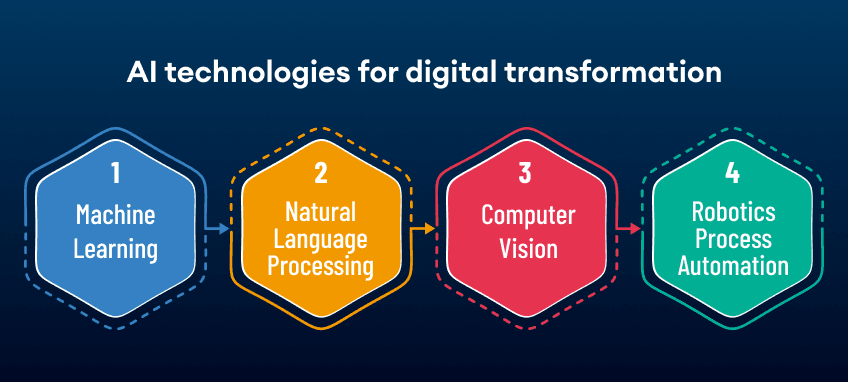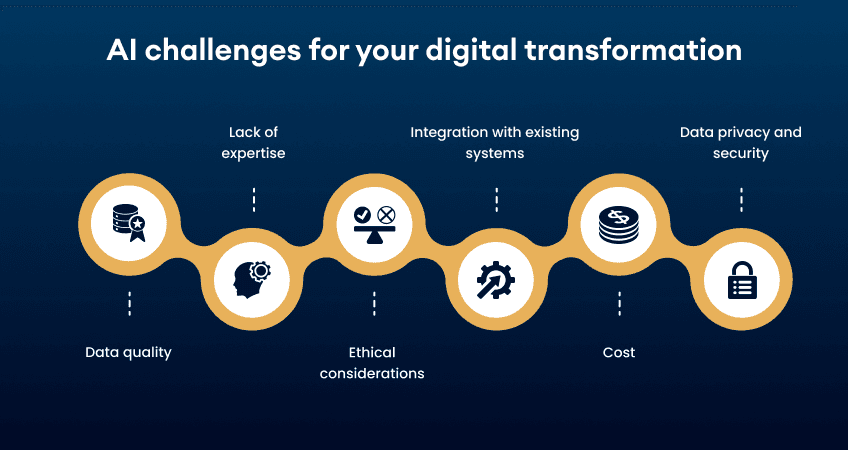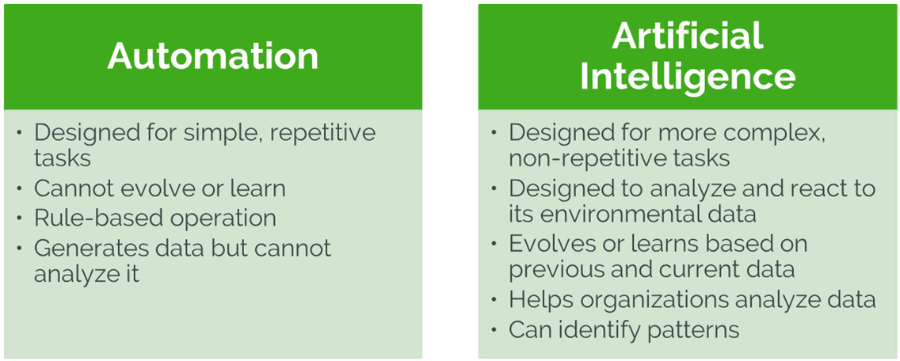Introduction to Digital Transformation Technologies
Digital Transformation Technologies have become indispensable for businesses seeking growth and innovation. Among these technologies, artificial intelligence (AI) stands out as a pivotal force driving digital transformation across various sectors. One of the key technologies in the digital transformation that is assisting companies in growing is artificial intelligence. In fact, the most recent Research and Markets research predicts that AI will expand at a compound annual growth rate of 52% by 2025, demonstrating the growing uptake of this technology by multinational corporations.
These days, artificial intelligence (AI) is being used and incorporated into many different industries, including national security, healthcare, logistics, and education. Let’s examine how it aids member-based organizations in expediting their Digital Transformation Technologies process.
The Rapid Growth of AI and Digital Transformation Technologies
These days, it’s becoming simpler to locate AI solutions with a range of industry applications.
For example, business tools include those for operations, automation, and customer service. They can also be applied to data integration, analysis, and visualization. AI solutions are becoming a vital component of any brand’s marketing toolkit. Artificial intelligence can help email marketers create content more rapidly and increase the impact of their emails.
Artificial intelligence tools are also benefiting other businesses and sectors, including healthcare, telecom, retail, and education.
The artificial intelligence (AI) industry is expected to reach a valuation of USD 1,811.75 billion by 2030, with a compound annual growth rate (CAGR) of 37.3% from 2023 to 2030, as the world gradually adopts AI.

What is Artificial Intelligence?
The field of computer science known as artificial intelligence (AI) focuses on creating devices or systems that can replicate the functions of the human brain. An AI system, for example, may solve issues, automate repetitive processes, and draw lessons from the past. The idea that artificial intelligence (AI) is limited to building intelligent devices or systems is a prevalent and constrictive viewpoint on the field. But that’s not even close to the complexity of AI. Natural language processing (NLP), deep learning, and machine learning are a few of the parts of AI systems. Large volumes of training data are fed into AI systems, which then use the analysis to find patterns or connections that can be used to forecast outcomes.
How AI Is Driving Digital Transformation Initiatives
The term “digital transformation” (DX) describes how businesses use Digital Transformation Technologies to encourage adjustments to or transformations of current business practices, cultures, and experiences. Businesses may become more efficient and flexible, as well as better respond to shifting consumer and market demands, by embracing digital transformation.
Because automation and artificial intelligence (AI) seem similar at first, they are sometimes used interchangeably. But they’re not the same thing. It’s critical that we understand the distinctions between automation and artificial intelligence (AI) before delving further into how AI supports digital transformation efforts.
Automation is the ability of a system to function independently with little to no assistance from humans. It is frequently used to complete repetitive activities and operates by adhering to a set of patterns or rules.

How Is Artificial Intelligence Different from Automation?
Artificial Intelligence (AI) and automation, while they may appear similar, are fundamentally different concepts.
Automation involves the execution of predefined tasks according to pre-programmed rules without human intervention. Its primary aim is to streamline repetitive tasks, thereby saving time and resources, and enabling employees to focus on more complex assignments.
On the other hand, Artificial Intelligence (AI) simulates human cognitive processes. It involves the analysis of vast datasets to derive insights and make recommendations for organizational improvements. This process relies on machine learning (ML) models, which continuously learn and adapt based on data inputs. Unlike automation, AI operates seamlessly, leveraging advanced algorithms and processing power to enhance decision-making and efficiency.
Although automation is predominantly associated with traditional software, AI is increasingly integrated into processes through a method known as AI automation. This hybrid approach combines the speed and efficiency of automation with the cognitive capabilities of AI, offering organizations a powerful toolset for optimizing operations and delivering personalized experiences.
In the context of member-based organizations, AI automation plays a vital role in understanding member preferences, identifying areas for improvement, and enhancing overall satisfaction. By leveraging AI-driven insights, organizations can tailor their offerings to meet the specific needs and interests of their members, ultimately fostering loyalty and engagement
Machine Learning: Data-Driven Insights
Machine learning algorithms enable computers to learn from data and improve their performance over time without explicit programming. In the realm of digital transformation, machine learning facilitates the analysis of vast datasets to extract valuable insights and inform strategic decision-making processes. By identifying patterns, trends, and correlations within data, machine learning algorithms empower organizations to optimize operations, personalize customer experiences, and drive innovation.
Deep Learning: Power of Neural Networks
Deep learning, a subset of machine learning, focuses on training artificial neural networks to perform tasks with human-like proficiency. Through layers of interconnected nodes, deep learning models can process complex data structures and extract high-level abstractions, enabling them to excel in tasks such as image recognition, speech recognition, and natural language understanding. In the context of digital transformation, deep learning empowers organizations to unlock new possibilities in data analysis, predictive analytics, and automation, thereby driving efficiency and innovation.
Neural Networks: Mimicking the Human Brain
Neural networks, inspired by the structure and function of the human brain, form the foundation of many AI applications. These interconnected networks of artificial neurons enable machines to learn from data, recognize patterns, and make decisions in a manner analogous to human cognition. In the context of digital transformation, neural networks enable advanced capabilities such as image recognition, predictive modeling, and anomaly detection, empowering organizations to extract actionable insights from complex datasets and drive strategic initiatives.
Natural Language Processing: Enhancing Human-Computer Interaction
Natural language processing (NLP) enables machines to understand, interpret, and generate human language, bridging the gap between humans and computers. By analyzing and processing vast amounts of textual data, NLP algorithms facilitate tasks such as sentiment analysis, language translation, and chatbot interactions. In the context of digital transformation, NLP plays a crucial role in improving customer engagement, streamlining business processes, and enabling seamless communication across platforms.

Big Data Analysis:
Big data analysis involves the collection, storage, and analysis of large and complex datasets to extract actionable insights and drive informed decision-making. With the proliferation of digital technologies, organizations have access to unprecedented volumes of data from various sources, including social media, sensors, and transaction records. By harnessing the power of AI-driven analytics tools, businesses can uncover hidden patterns, trends, and correlations within big data, enabling them to optimize operations, mitigate risks, and capitalize on emerging opportunities.
Chatbots and Virtual Assistant: Customer Interactions
Chatbots and virtual assistants leverage Digital Transformation Technologies to simulate human-like conversations and provide personalized assistance to users. These AI-powered interfaces enable organizations to automate customer support, streamline business processes, and enhance user experiences across various channels. By leveraging natural language understanding and machine learning algorithms, chatbots can engage in meaningful interactions with users, address inquiries, and provide relevant information in real-time, thereby improving customer satisfaction and loyalty.
In conclusion, artificial intelligence serves as a driving force behind Digital Transformation Technologies, empowering organizations to harness the power of data, automation, and intelligent technologies to drive innovation, enhance efficiency, and deliver superior customer experiences. By leveraging machine learning, deep learning, neural networks, natural language processing, big data analysis, and chatbots/virtual assistants, businesses can unlock new opportunities, optimize operations, and stay ahead in today’s competitive landscape.
FAQs (Frequently Asked Questions)
1. How does AI enhance member engagement for organizations?
AI enables hyper-personalization, allowing organizations to tailor content and recommendations to individual member preferences, thereby fostering deeper engagement.
2. What role does AI play in decision-making processes within member-based organizations?
AI facilitates data-driven decision-making by analyzing vast datasets to uncover trends, predict outcomes, and optimize strategies for organizational growth.
3. Can AI automation replace human involvement entirely in member interactions?
While AI automation streamlines processes and enhances efficiency, human involvement remains crucial for complex interactions requiring empathy and nuanced understanding.
4. How does AI integration with cloud technology benefit member-based organizations?
The collaboration between AI and cloud technology offers scalability and computational power, enabling organizations to leverage advanced analytics and drive innovation.
5. What are some potential challenges of implementing AI in member-based organizations?
Challenges may include data privacy concerns, ensuring algorithmic transparency, and overcoming resistance to change among staff and members.
